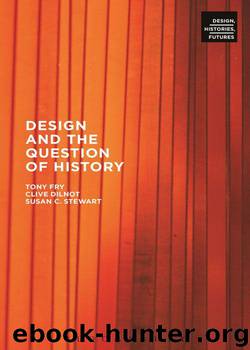Design and the Question of History (Design, Histories, Futures) by Fry Tony & Dilnot Clive & Stewart Susan

Author:Fry, Tony & Dilnot, Clive & Stewart, Susan [Fry, Tony]
Language: eng
Format: mobi
Publisher: Bloomsbury Publishing
Published: 2015-02-26T05:00:00+00:00
If in design history is discounted, elsewhere it is displaced. “The gift of art is the most original gift” says Agamben, because it “allows man to attain his original status in history and time in his encounter with it.”65 But what is originally situated “in a more essential dimension” in which the work interrupts the “homogeneity of profane time” and opens us—throws us—back into what can be felt perceptually as a more original time (time which contains the infinite space of reflection on being) cannot be maintained.
Two impulses shatter this “concrete space of the work.” The most immediately obvious, the one that most defines our time, is the detachment that comes from the aesthetic standpoint: “When the work of art is instead offered for aesthetic enjoyment and its formal aspect is appreciated and analysed … the origin that gives itself in the work of art and remains reserved in it”66 ceases to be visible. The impulse to “free the work” from its dependence on the Mythic context, loses the original ek-stasis but substitutes for this the play of form and thus displaces ecstasy in favor of contemplative detachment. This detachment however, which is translated into aesthetics, and later into ideologies of professional autonomy, erases the prior understanding, “the engagement that keeps man in the truth and grants to his dwelling on earth its original status”).67
“Aesthetics, then,” says Agamben, “is unable to think of art according to its proper statute, and so long as man is prisoner of an aesthetic perspective, the essence of art remains closed to him.”
Aesthetics cannot think this essence because it is in itself displacement (it is precisely as a series of displacements that we can best grasp Kant’s Critique of Judgment). Aesthetics cannot think this because it loses, as the work itself loses, even deliberately, the original experience. Thus both “the engagement that keeps him in the truth and grants to his dwelling on earth its original status” and “the space in which once man’s action and the world found their reality in the image of the divine, in which man’s dwelling on earth used to take its diametrical measurement”68 disappears, both in actuality and in thought. This is the victory of modern aesthetics, and it is, as we know, comprehensive.
In design, this is seen nowhere more sharply than in contemporary building. Architecture in the present is more configuratively emancipated—or at least is permitted a greater degree of formal play—than at any time in the recent past. Seemingly (if not in truth) unhampered by necessity, it appears to have achieved an enviable condition of weightlessness and artless freedom, one that belies the necessity of anything that might tie down the formal imagination.
Yet outside of Italo Calvino—who famously placed lightness as the first of the virtues for our millennium69—others have been less sure. As the title of his most well-known work suggests, The Unbearable Lightness of Being is Milan Kundera’s understanding of lightness not as a virtue but a threat, not a freeing but its opposite, “a terrifying burden not to be borne another instant.
Download
This site does not store any files on its server. We only index and link to content provided by other sites. Please contact the content providers to delete copyright contents if any and email us, we'll remove relevant links or contents immediately.
POP by Steven Heller(3308)
Japanese Design by Patricia J. Graham(3110)
The Power of Broke by Daymond John(2897)
Architecture 101 by Nicole Bridge(2765)
Indistractable: How to Control Your Attention and Choose Your Life by Nir Eyal(2335)
Fusion 360 for Makers by Lydia Sloan Cline(2308)
Batik by Rudolf Smend(2124)
Actionable Gamification: Beyond Points, Badges, and Leaderboards by Yu-kai Chou(2123)
Origami Art by Michael G. Lafosse & Richard L. Alexander(2065)
Homebody by Joanna Gaines(2033)
Whiskey in a Teacup by Reese Witherspoon(1936)
Worn in New York by Emily Spivack(1927)
Feng Shui by Stephen Skinner(1902)
Austin Kleon by Steal Like an Artist(1888)
Simple Gatherings by Melissa Michaels(1856)
Don't Make Me Think, Revisited: A Common Sense Approach to Web Usability by Steve Krug(1826)
Hygge: The Danish Art of Happiness by Marie Tourell Søderberg(1694)
The Joy of Hygge by Jonny Jackson(1687)
The Laws of Simplicity by John Maeda(1568)
